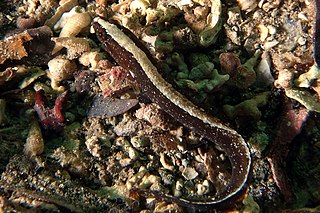
Combtooth blennies are blenniiformids; percomorph marine fish of the family Blenniidae, part of the order Blenniiformes. They are the largest family of blennies with around 401 known species in 58 generas. Combtooth blennies are found in tropical and subtropical waters in the Atlantic, Pacific and Indian Oceans; some species are also found in brackish and even freshwater environments.

Clinidae is a family of marine fish in the order Blenniiformes within the series Ovalentaria, part of the Percomorpha. Temperate blennies, the family ranges from the Atlantic, Pacific, and Indian Oceans, in both the Southern and Northern Hemispheres. The family contains about 86 species in 20 genera, the 60-cm-long giant kelpfish being the largest; most are far smaller.

Chelodina, collectively known as snake-necked turtles, is a large and diverse genus of long-necked chelid turtles with a complicated nomenclatural history. Although in the past, Macrochelodina and Macrodiremys have been considered separate genera and prior to that all the same, they are now considered subgenera of the Chelodina, further Macrochelodina and Macrodiremys are now known to apply to the same species, hence Chelydera is used for the northern snake-necked turtles.

Helcogramma is a genus in the triplefin family Tripterygiidae. The blennies in the genus Helcogramma are found throughout the Indo-Pacific and in the South Atlantic Ocean off the islands of St Helena and Ascension.

Malacoctenus is a genus of labrisomid blennies native to the eastern Pacific Ocean and the Atlantic Ocean.

Entomacrodus is a genus of combtooth blennies.

Ecsenius is a large genus of fish in the family Blenniidae.
Alloblennius is a genus of combtooth blennies found in the western and northeastern Indian Ocean.

Omobranchus is a large genus of combtooth blennies found in the Pacific, Atlantic, and Indian oceans.
Omox is a small genus of combtooth blennies found in the western Pacific Ocean.

Xiphasia is a small genus of combtooth blennies found in the Pacific and Indian Oceans.
Stathmonotus is a genus of chaenopsid blennies found in the Pacific and Atlantic oceans.
Ophiclinops is a genus of clinids native to the coast of southern Australia.
Ophiclinops hutchinsi, the Earspot snakeblenny, is a species of clinid native to reefs with seagrass or weed growth at depths of from 13 to 15 metres along the coast of south east Western Australia.
Ophiclinus antarcticus, the Adelaide snake blenny, is a species of clinid found in the coastal waters of southern Australia. It can reach a maximum length of 14 centimetres (5.5 in) TL. It often has dark blotches and speckles on its body and fins, with a series of large white blotches along the midside, dorsal-fin base and just above the anal-fin base. It also has several dark stripes that often radiate from its eyes and dark brown markings on the lips and lower side of the head.
Ophiclinus brevipinnis, the Shortfin snakeblenny, is a species of clinid found in the coastal waters of southern Australia where it inhabits the spaces under rocky ledges and can also be found in weed patches at a depth of around 15 metres (49 ft). It can reach a maximum length of 7 centimetres (2.8 in) TL.
Ophiclinus pectoralis, the whiteblotch snakeblenny, is a species of clinid found in reefs around western Australia preferring weedy and sandy areas at depths of about 13 metres (43 ft). It can reach a maximum length of 6 centimetres (2.4 in) TL.

Ophiclinus ningulus, the variable snake-blenny, is a species of clinid found in reefs around southern Australia, preferring areas with plentiful growth of sponges at depths of from 5 to 20 metres. It can reach a maximum length of 7.5 centimetres (3.0 in) TL.

Paraclinus is a genus of labrisomid blennies native to eastern Pacific Ocean and the western Atlantic Ocean.

Starksia is a genus of labrisomid blennies native to the western Atlantic Ocean and the eastern Pacific Ocean. Their typical length is 2 cm (0.79 in) SL. The generic name honours the American ichthyologist Edwin Chapin Starks (1867-1932) of Stanford University for his work on Pacific coastal fishes. As a genus Starksia is distinguished from other labrisomids by their scaled bodies, two obvious soft rays in the pelvic fin and the male's have an intromittent organ which is near to or attached to the first spine of their anal fins, which is also somewhat separated from the fin.












